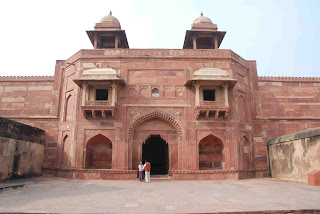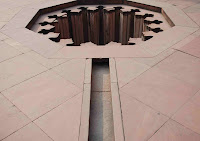Route of the Ancient Traders
Day 30 - Day 31
Overland
Agra, India
Mostly Sunny - 88 Degrees
Thursday, December 10th
Day 30
As we awoke at 5:30 for a sunrise visit to the Taj Mahal, the wedding from the night before was still going strong. We admired their stamina as we stumbled around the room.
It was the same procession of chaos to get to the Taj, but the gauntlet was quieter. The shops were just starting to open, the shopkeepers burning fires of dung out front to bake their bread and heat their tea for breakfast. A paperboy made his deliveries and we stood in line waiting for the gates to open.
Much is made of the transformation of the Taj by changing light throughout the day, but the pollution serves as a consistent filter, obscuring the impact of the light. Nevertheless, sunrise at the Taj Mahal is a magical time. The monument is shrouded in mist and there are very few people to compete for the views. This is the peace that we have come here to feel.

Later in the morning, we drove out into the Indian countryside to visit Fatehpur Sikri, the red sandstone former capital of the Mughal Empire. It is accented with the inlaid white marble perfected on the Taj Mahal and has Jain, Hindu, and Islamic influences. Here, Emperor Akbar ruled with his four wives, each with her own mosque and living quarters. This sprawling hill-top palace was completed in 1571 and abandoned just 14 years later. The water supply dried up and draught forced the capital to move.



In the afternoon, we paid a visit to the Tomb of Itmad-ud-Daulah in the old city of Agra. Itmad-Ud-Daulah was the first Mughal structure totally built from marble and pioneering the extensive use of "pietra dura," the inlay work so characteristic of the Taj Mahal.

Friday, December 11th
Day 31

This morning we visited Agra Fort, another World Heritage Site credited to Emperor Akba, India’s great visionary. This was the seat of the Mughal Empire in Agra.


The artistry and the engineering here are amazing. The fort was constructed with red sandstone and accented with white marble, some of it carved so delicately that it looks like stained glass as sunlight shone through. An intricate drainage system throughout the fort collected rainwater for drinking, irrigation, reflecting pools, and fountains.


Ironically, Emperor Akba was deposed by his son and imprisoned in a tower here with a view of the Taj Mahal and his fallen bride.

Our charter to Goa was delayed by smog and air traffic above near-by Delhi, but we finally got off the ground in another Kingfisher Airlines A-320. Supposedly we won the business class seats in a drawing, but we suspect that our friend the ShoreEx Manager Nicki may have helped us out.
Goa, India
We were met at the airport and loaded onto buses for a late tour of Goa. As we pulled out of the airport onto the road, traffic conditions were more of the same, only worse. They say the roads are under construction; they are widening to four lanes. Things must be getting worse before they get better. In Goa, there is a saying, "In the rest of India, they drive on the left of the road. In Goa, we drive on what's left of the road." Brilliant!!!
Traffic in Goa was no better, but the standard of living was markedly different. The climate here is tropical and the land is jungle-like. The population is much lower, the literacy rate is higher, and the Portuguese seem to have left a better legacy in the South than the British did in the North.
We rode through the jungle to Old Goa to see the Basilica of Bom Jesus, famous throughout the Catholic world as the home of the remains of the missionary, St. Francis Xavier. It is said that his remains never decomposed.


He is on display in a side chapel and there is a window into his coffin. Every ten years, they take him down from the alter so pilgrims and get a closer look. This last happened in 2004 and more than two million people came to view the spectacle.

We Continued on to Panjim, the capital of the region. This is a modern beach resort and governmental center with Portuguese-style winding streets and old houses with red-tiled roofs and overhanging balconies. It is one of India’s smallest and most pleasant capitals and the only thing close to charming we have seen in India.
It was another rough and winding drive back to the ship.
Next Stop: Mangalore, India

Wow, sounds (and looks) like the pollution there is horrible. What a shame. I am embarassed to admit that I did not know about the Portugese influence in this part of India. Very interesting!
ReplyDelete